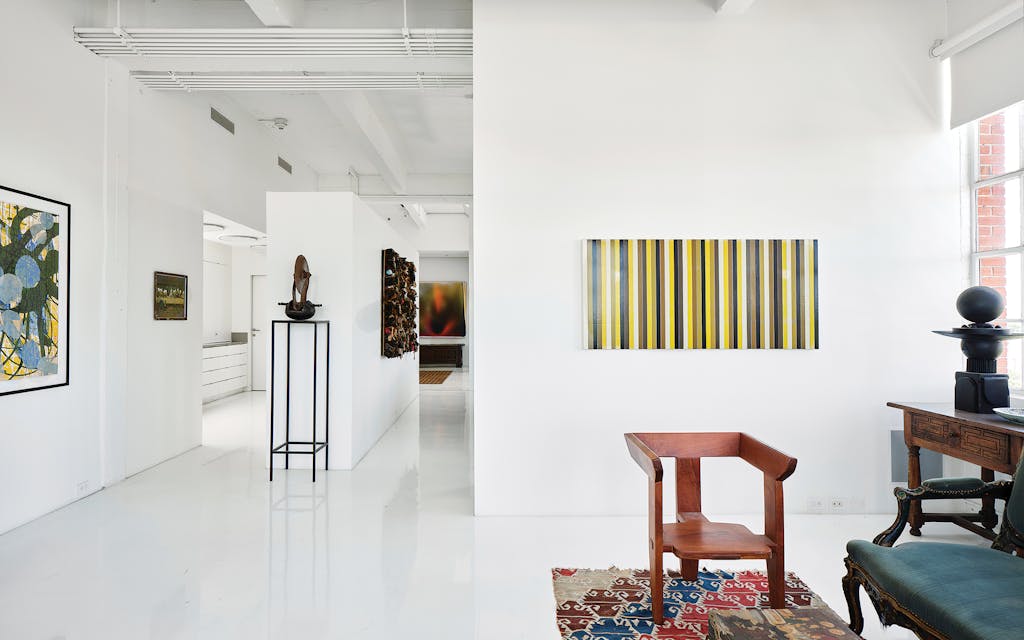Some über-wealthy Texans surround themselves with vast acreages of ranchland, while others build out enormous garages for sports cars or room-size closets for designer apparel. Late San Antonio philanthropist Linda Pace, whose family made a fortune in the salsa business, immersed herself in contemporary art. In the early 2000s, the founder of the Artpace residency program purchased a six-story former candy factory—and, for six decades, the headquarters of Tobin Surveys Inc.—on Camp Street in Southtown to renovate into residential lofts, keeping the top two floors and roof deck for herself. That 15,000-square-foot, six-bedroom penthouse, now up for public sale, is custom-made for an art patron with an extensive collection.
The floors shine pristinely white, as do the walls, which are reinforced with plywood for hanging large canvases and other works. Sizable sculptural installations can easily fit in the massive rooms. The sixth floor of the building is devoted almost entirely to exhibition space, plus a second kitchen and a three-bedroom wing.


The property, which hit the market last fall and is listed at $7.25 million, also comes with more than two thousand square feet of art storage. “It’s a lot to fill,” admits the condo’s current owner, Chris Erck, a friend of Pace’s and a collector himself.
Residences of this size and postindustrial charm are exceedingly rare in the San Antonio market, says Michael Reisor, of real estate firm Douglas Elliman, who is handling the listing. He suspects the apartment might go to an international buyer or maybe an Austinite, adding that he’d list it at $19.5 million if it were in Austin (“It would have sold in five seconds”). The luxury market is much hotter there, he notes, with a sprawling effect that is beginning to reach San Antonio’s doorstep. Whoever that buyer turns out to be, they might want to freshen up the rooftop swim and spa area, picturesquely located directly beneath the original 1926 water tower. But no renovation could erase Pace’s spirit from the property.
Pace, who died at 62 in 2007, was a vocal believer in the power of dreams, and one can feel her presence here, where she spent her last years. Look out one exposed-brick window and you’ll see Ruby City, the art center that was designed by David Adjaye and opened in 2019 to keep Pace’s collection on permanent public display. Look out another and there’s Chris Park, which features visual experiences designed by Teresita Fernández in memory of Pace’s deceased son. Each night, 55 blue LED lights laid into the park’s stone terrace shine in a pattern resembling the constellations as they appeared when Chris was born.
video Tour: inside the camp Street PENTHOUSE
Real estate agent Michael Reisor gives viewers a quick tour of the 15,000-square-foot residence.
Through her Artpace residency program, Pace nurtured generations of artists in San Antonio, from Jesse Amado to Dario Robleto, while also bringing major stars such as Isaac Julien and Leonardo Drew to town for lengthy visits. One can imagine the penthouse in her heyday adorned with works by these artists. It’s actually easy to do, because Erck has filled the condo’s galleries with many pieces related to her legacy, including a few Drew creations and a large, skyward-reaching sculpture by Artpace alumnus Christian Marclay featuring a drum set that once belonged to a teenaged Chris.
Pace’s generosity did much to put her home city on the map for art enthusiasts, with the Camp Street condo acting as a hub for the comings and goings of art-world personalities from around the globe. According to Kelly O’Connor, who was Pace’s studio assistant for many years and is now the head of collections and communications for Ruby City, Pace referred to her home as “Grand Central Station” and kept a quesadilla corner in the kitchen fully stocked with her family’s picante sauce, so that visitors passing through could always grab a snack.

It’s a bit melancholic to think that this once vital crossroads of San Antonio and the international art world had lain uninhabited for nearly a decade after Pace’s death; Erck didn’t acquire the condo from the estate until 2016. With Ruby City just down the block, however, and with the adjacent San Pedro Creek undergoing significant revitalization as a “culture park,” the place feels primed for a rebirth. There will never be another Linda Pace—her legacy as a patron of the arts in San Antonio is unsurpassed. But if anyone were to try to pick up where she left off, this could be an auspicious place to start.
Michael Agresta writes about art, culture, and technology for this magazine and other publications, including the Atlantic, Slate, Travel + Leisure, the Wall Street Journal, and Wired.
This article originally appeared in the July 2022 issue of Texas Monthly with the headline “An Art Collector’s Dream.” Subscribe today.
- More About:
- Style & Design
- Architecture
- San Antonio







